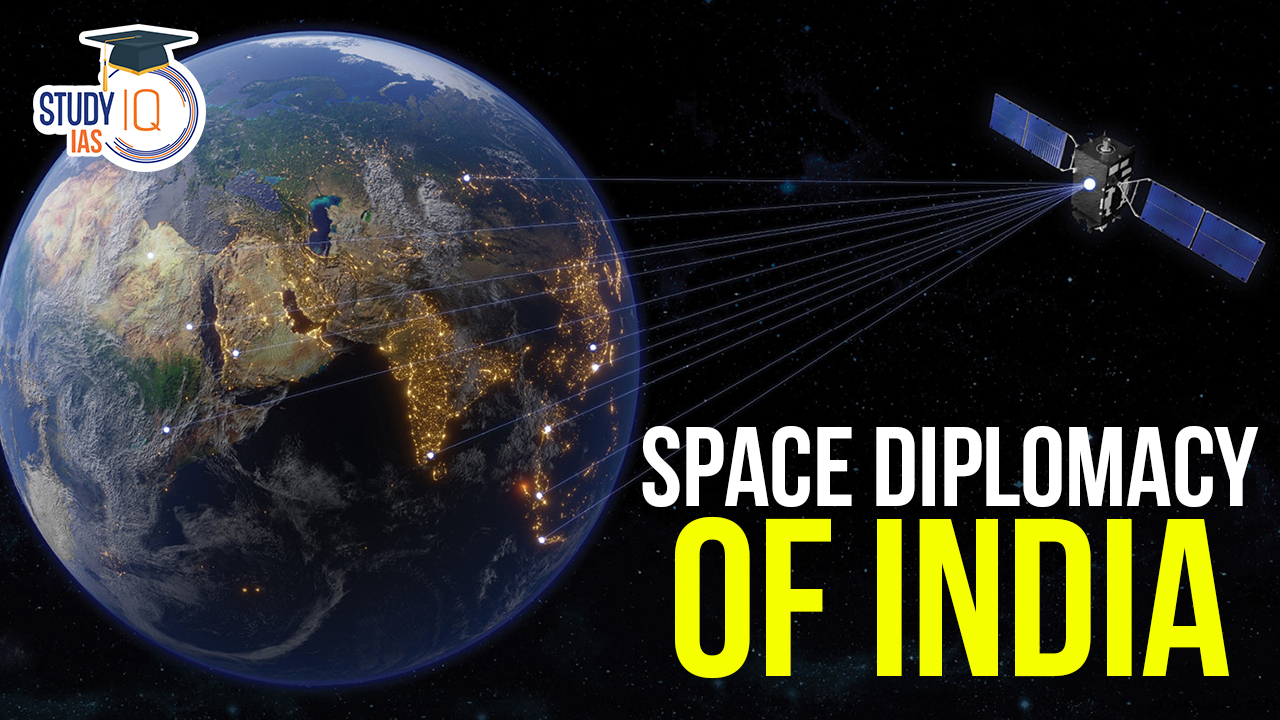Table of Contents
India has been actively engaged in space diplomacy for several years. Space diplomacy refers to the use of space technology and cooperation in the field of space exploration and satellite technology to foster international collaboration, strengthen diplomatic relations, and promote peaceful uses of outer space. Read about key aspects of India’s space diplomacy in this Article.
India’s Space Diplomacy
Space diplomacy enhances a nation’s negotiation power, as exemplified by Russia’s launch of India’s first satellite in exchange for port access. In the contemporary global landscape, experts and policymakers recognize space as a crucial tool for addressing global challenges, fostering better terrestrial relations through space exploration. This diplomatic art aims to secure peaceful coexistence in outer space, essential for humanity’s future. With space exploration constrained, space diplomacy fosters international cooperation to harness space resources for the Earth’s growing population.
We’re now on WhatsApp. Click to Join
India’s efforts in space
On November 21, 1963, India marked the inception of its space program with the launch of its first rocket at the Thumba Equatorial Rocket Launching Station (TERLS) near Thiruvananthapuram. Situated on the geomagnetic equator, Thumba played a vital role. The inaugural rocket, Nike-Apache, was sourced from the United States. Over the years, India has achieved significant milestones in space exploration, extending its contributions to neighboring nations and beyond. Key assets in this endeavor include the PSLV and GSLV launch vehicles, with notable missions like Aryabhata (1975), Chandrayaan 1 and 2, and a successful Mars mission.
International Body for Space Diplomacy
| International Body | Purpose and Key Agreements | Members/Participants | Headquarters |
| United Nations Committee on the Peaceful Uses of Outer Space (COPUOS) | Develops International Space Law and concluded five key treaties: Moon Agreement, Liability Convention, Outer Space Treaty, Rescue Agreement, and Registration Convention. | International organization that operates under the United Nations. | N/A (Operates within the UN system) |
| United Nations Office for Outer Space Affairs (UNOOSA) | Serves as the secretariat for COPUOS, implements international space law, and maintains the United Nations register of objects launched into outer space. | N/A (Operates under the United Nations) | Vienna, Austria |
| Asia-Pacific Space Cooperation Organization (APSCO) | An intergovernmental organization with the objective of sharing data, tracking space objects, and establishing a space communication network. | Members: Bangladesh, China, Iran, Mongolia, Pakistan, Turkey, Peru, Thailand Observer: Mexico Signatory: Indonesia | Beijing |
Key Aspects of India’s Space Diplomacy
International Partnerships
India has a history of collaborating with various countries and space agencies, such as NASA (United States), Roscosmos (Russia), ESA (European Space Agency), and others. These collaborations include joint space missions, sharing satellite data, and technology exchange.
South Asian Association for Regional Cooperation (SAARC)
India has offered its assistance to neighboring countries in South Asia by launching and operating their communication and earth observation satellites. This cooperation not only strengthens regional ties but also helps in disaster management and resource monitoring.
Astrosat
India’s Astrosat, launched in 2015, is the country’s first dedicated multi-wavelength space observatory. It plays a role in global space-based astronomical research and collaborations with other space agencies and research institutions worldwide.
International Telecommunication Union (ITU)
India actively participates in ITU’s satellite coordination activities and adheres to international regulations to ensure responsible and peaceful use of space-based communication technology.
United Nations Office for Outer Space Affairs (UNOOSA)
India has been involved in various UNOOSA activities, including discussions on space law, policies, and guidelines for the peaceful use of outer space.
Space Technology for Diplomacy
India has offered assistance in launching and operating satellites for various countries, primarily for communication, earth observation, and remote sensing purposes. These initiatives have contributed to India’s positive image as a responsible space-faring nation.
Chandrayaan and Mars Orbiter Missions
India’s Chandrayaan and Mars Orbiter Missions have garnered international attention and goodwill, leading to collaborations with other space agencies and countries for lunar and Martian research.
Global Navigation Satellite System (IRNSS/NavIC)
India’s NavIC system provides regional satellite navigation services to India and neighboring regions. It has the potential for international partnerships in navigation and location-based services.
Space Policy and Guidelines
India has articulated its space policy, emphasizing peaceful uses of outer space, international collaboration, and the avoidance of the militarization of space. It has also released guidelines for responsible behavior in outer space.
Space Outreach
India has actively engaged in space outreach programs, including hosting international space conferences, workshops, and promoting STEM education. These efforts help in fostering space-related cooperation and goodwill with other nations.
Challenges to Space Diplomacy of India
Space diplomacy confronts significant challenges stemming from the increasing number of spacefaring nations, fostering competition for both celestial and terrestrial resources. The weaponization of outer space, particularly through nuclear missiles capable of satellite disruption, poses a grave concern. Historical incidents like the 1962 US nuclear test, which damaged several satellites, exemplify this peril.
Smaller and developing nations often lack full space sovereignty and rely on countries with robust launch capabilities. The pursuit of space endeavors by these countries can divert resources from essential societal needs. Anti-satellite tests further jeopardize space programs and introduce a new realm of conflict. Additionally, the proliferation of space participants exacerbates the space debris problem, hindering satellite operations.
The scarcity of comprehensive space treaties results in limited legal constraints, potentially precipitating disorder in the cosmic domain. These issues underscore the intricate landscape of space diplomacy.
Space Diplomacy of India UPSC
India’s space diplomacy is marked by international collaborations, offering satellite services to neighboring countries, and actively participating in UN initiatives. Key achievements include Astrosat, Chandrayaan, Mars missions, and the NavIC satellite system. Challenges include the growing number of spacefaring nations leading to resource competition, weaponization concerns, and smaller nations’ dependence on launch capabilities. Anti-satellite tests and increasing space debris pose risks. Limited space treaties create legal ambiguities. India’s space diplomacy seeks to balance these opportunities and challenges in the context of a rapidly evolving and crowded space environment, fostering international cooperation while addressing critical terrestrial needs.


 Nipah Virus (NiV): Structure, Testing Me...
Nipah Virus (NiV): Structure, Testing Me...
 What is Ham Radio and its Purpose?
What is Ham Radio and its Purpose?
 INS Udaygiri, Key Features, Capabilities...
INS Udaygiri, Key Features, Capabilities...





















